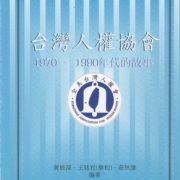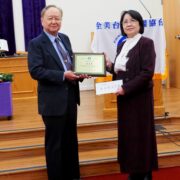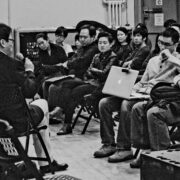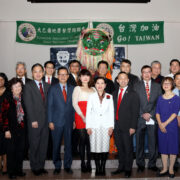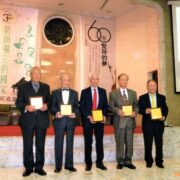Brief Introduction to the Formosan Association for Human Rights
Edited by Ken S. Huang, TingYee Wang, and Strong Chuang
Overseas Taiwanese people have been engaged in rescuing political victims, caring for victims’ families, and the movement against the Kuomintang’s human rights violations since the early 1960s.
At the time, every time that there was a case of political persecution or human rights violation, members of the United Formosan for Independence and supporters of the Taiwan Independence movement would gather with their wives and children on the streets, marching with flags, distributing informational pamphlets, and shouting slogans to protest against the Kuomintang’s acts of political persecution.
Incidents continued to occur one after another, and as our experience accumulated and we continued to learn, we had a revelation: if we wanted to defeat the Kuomintang and get results, we needed to organize ourselves to promote and adopt a new method: using international pressure.
In 1976, Tina Chang collaborated with over ten people, including members of the local New York organization, United Formosans for Independence, and other passionate women like Hui-mei Tai, Li-chan Lin, and Chien-ho Lin to establish the Committee for Taiwan Human Rights. Tina Chang was in charge coordinating and executing the organization’s tasks. James Symour, a Colombia professor with human rights work experience and a grand vision, suggested that the committee change its name to the Formosan Association for Human Rights. Tina Chang and the other women of the association agreed and accepted his proposal. Thus, the Formosan Association for Human Rights was born.
That same year, there was a group of Taiwanese in Los Angeles, California, who were passionate about Taiwanese human rights; this group, which included Kai-shih Hsu, Chien-hui Hsu, Ching-chiang Kuo, Chi-shih Chang, Teh-ho Cheng, and Ting Yee Wang formed The Taiwan Human Rights & Culture Association. Since the two groups had the same mission and goals, they agreed to work together under the umbrella of the Formosan Association for Human Rights, promoting cooperation on human rights advocacy work.
Responding to advocacy by the Formosan Association for Human Rights and the United Formosans for Independence, the United States Congress held a “Taiwan Human Rights Hearing” in 1977 to publicly expose the Kuomintang’s acts of political persecution and human rights violations. Chang Chin-tse and Wu Ming-hui, who had just escaped from Taiwan to the United States, represented the Taiwanese people. This was the first opportunity for overseas Taiwanese to bring Taiwan’s political and human rights issues onto the international stage.
After the Wang Sing-nan Incident occurred, the Formosan Association for Human Rights and the United Formosans for Independence jointly began rescue work: preparing a public announcement to be published in the New York Times and arranging for Wang Sing-nan’s sister to attend the U.S. Congress “Taiwan Human Rights Hearing.” The Formosan Association for Human Rights asked Chien-hui Hsu to take over responsibility of affairs, and in 1977, she took over. While she was in Japan, she collaborated with members of United Formosans for Independence and enthusiastic women like Hsueh-mei Wang, Hsueh-o Kuo, Mei-ling Chin, Lien-chih Huang, Ching-fen Mao, Grace Yeh, and Minako Hayashi, who have been involved in the human rights movement since 1964. This army of women also has a good relationship with Masanari Kobayashi and Kiyoko Miyake. Thanks to the help of these two, the group of women were able to collect a fairly comprehensive list of political victims and information on prison torture. Because of these women’s help, Amnesty International London had the evidence to finally launch a global campaign to rescue political victims in Taiwan. Amnesty International branches in 35 different countries, including the United Kingdom, United States, Netherlands, Sweden, Germany, New Zealand, and Japan, began to grant amnesty to prisoners of conscience from Taiwan. Included in those who were granted amnesty during that time were: Tsung Ming Roger Hsieh, Wei Chao-ting, Su Tung-chi, Ming-tan Huang, Philip Lin, Yung-chuan Chen, Cheng-liang Yu, and Ching-shan Chen.
In the fall of 1978, there were rumors flying around in Washington that the United States was planning to sever diplomatic relations with Taiwan and officially recognize the government of China. Kuo Yu-hsin, chairman of the Overseas Alliance for Democratic Rule in Taiwan, immediately instructed Secretary-general Neng-Hsiang Wang to prepare a response to the imminent situation. On December 16th, 1978, President Carter announced that the United States had officially severed diplomatic relations with Taiwan. Taking that year’s “Taiwan Human Rights Hearing” as his model, Neng-Hsiang Wang began working as a go-between, lobbying Congressman Jim Leach of Iowa and Senator Claiborne Pell of Rhode Island to hold separate hearings to ensure the safety of Taiwan.
Leach had once worked as a secretary in the United States Embassy in Japan, and Pell had been a U.S. Naval Officer, trained to take over Taiwan after World War II. Both had a good understanding of the political situation in Taiwan and they really sympathized with the residents of Taiwan. Finally, a joint “Taiwan Security Hearing” was held to collect information to form the basis of a national law. Before the end of the hearing, Senator Pell asked the audience whether there were any additional issues to add. Tan-Sun Mark Chen raised his hand and requested that the United States Congress protect and respect the basic human rights of all of Taiwan’s residents.
The success of the Taiwan Relations Act can be attributed to a few individual leaders, as well as Taiwanese organizations: the United Formosans for Independence, the Taiwanese Association of American, the Formosan Association for Human Rights, and the Association for the Promotion of Freedom and Democracy in Taiwan, led by Ming-min Peng and R.H. Hwang (Shoki Coe). The hard work of certain individuals cannot be ignored either. Among these individuals is Strong Chuang, whose efforts to lobby the Directors of the National Association of Manufacturers and local Congressmen for their support of the proposal was one of many indirect contributions to the creation of the law.
Article 2 Section 3 of the Taiwan Relations Act specifically states that the human rights of the residents of Taiwan should be protected and strengthened. After the United States broke off its diplomatic relations with Taiwan and recognized China, the political situation and party tension in Taiwan increased daily. Tangwai (“outside-the-party”) individuals redoubled their efforts to obtain the right to political participation.
After Kaohsiung Incident (Formosa Incident) occurred on December 19th, 1979, the Kuomintang regime began arresting people. Chris Fan, President of the Formosan Association for Human Rights, his wife and secretary Shu-yun (Mei-fang) Fan, and a group of local Taiwanese community members united FAHR branches and Taiwanese Associations from across the country to launch a mission to rescue political victims and provide support to people in Taiwan. Every weekend, this team of Taiwanese community members met at Chris Fan’s home to manage and coordinate their work. The complete work is as listed below:
– Launched a letter-writing campaign to write to President Carter, Senator Kennedy, and Congressman Solarz.
– Provided financial support to help American human rights lawyers attend the Formosa Incident trial.
– Collaborated with The Asia Resource Center to publish two books: “Repression in Taiwan” and “Martial Law in Taiwan.”
– Released a book about the incident:「高雄事件」(Kaohsiung Incident)
– Raised over $100,000 to support victims, victims’ families, and Tangwai individuals living in Taiwan.
– Tron-Rong Tsai represented FAHR at U.S. Congress “Taiwan Human Rights Hearing.”
Shu-yun (Mei-fang) Fan not only helped manage the association’s affairs, she also helped care for the families of political victims. Following the Lin Family Massacre, the Lin family’s friends sent the only Lin family member who had managed to escape death, Lin Huan-chun (Judy Linton) to the United States to protect her life. Judy stayed at the Fan’s home for a period of time, and Shu-yun Fan raised her like her own daughter until she went to college. In its continued support of Tangwai individuals, the Southern California Taiwan Human Rights & Culture Association created Voice of Taiwan Independence. With TingYee Wang as the head writer and Chien-hui Hsu as the broadcaster, the show made regular broadcasts: the development of the Formosa Incident, the current situation of human rights in Taiwan, and the Taiwanese people’s desire to establish an independent nation. They also set up the “Voice of Taiwan Independence” radio station in New York, from where the station broadcasted news from inside and outside of the island, 24 hours a day.
In 1980, President Rui-feng Hsu of the New York branch of the Formosan Association for Human Rights registered FAHR as a non-profit, non-partisan organization with the IRS. In 1981, the IRS approved the application, and thus the Formosan Association for Human Rights became the very first legal and publicly active overseas Taiwanese organization.
After Chen Wen-Chen’s murder in 1981, the various branches of Formosan Association for Human Rights and local Taiwanese Associations came together to request that the U.S. Congress hold a hearing. The hearing was held on July 30th, and among the attendees were Tron-rong Tsai, Tan-Sun Mark Chen, and the President of Chen Wen-Chen’s University, Richard Cyert.
In 1982, President Rui-feng Hsu of the Formosan Association for Human Rights recognized that the important battlefield for Taiwanese human rights was in Taiwan, so he narrowed the association’s focus: to strengthen ties with Tangwai individuals on the island, to strive for the freedom of speech on the island, and to seek the support of international organization. The Formosan Association for Human Rights began publishing the Human Rights Newsletter, which they sent to representatives of varying levels and Tangwai figures in Taiwan. Thanks to this newsletter, Tangwai figures on the island were able to understand overseas human rights activities.
Since the association had a good relationship with Walter Cronkite of the Committee to Protect Journalists (CPJ), the CPJ once made note of the importance and necessity for the freedom of speech to the Kuomintang authorities.
The Formosan Association for Human Rights also arranged for Americans who had been deported by the Kuomintang government to visit various cities and speak to both Taiwanese and American audiences about the Kuomintang regime’s human rights violations in Taiwan. These individuals included: Father Ron Bockeri, Father James K., and Sister T. Madine. This was when the Catholic Church began publicly supporting the human rights movement in Taiwan.
Though the Formosan Association for Human Rights had already been established for some time, there had never been a logo. In 1986, President Hsin-chih Lin asked Ken S. Huang to design one. In October 1987, the Board of Directors approved the logo and began using it. The logo is the image of a bell, symbolizing freedom, because the Formosan Association for Human Rights strives for democracy, human rights, and to maintain freedom.
On December 13th, 1987, when the Southern California Formosan Association for Human Rights hosted “World Human Rights Day Event: Tsai Yu-chuan and Hsu Tsao-teh Discuss Independence” in Monterey Park, they received interference from the Monterey Park Police, who were photographing and videotaping the event for the police bureau of their sister city, Taipei County, to reference. Discontent with the police station’s interference, President Hsin-chih Lin of the Southern California FAHR branch and former President TingYee Wang, representing FAHR, collaborated with the local branch of the ACLU to report the police station’s violation of human rights to the local court. For many years, it had been a well-known secret that the Kuomintang’s secret agents had been filing reports on Taiwanese individuals and colluding with foreign agencies to interfere with Taiwanese people’s activities. After this lawsuit began to spread, it attracted media attention. When the local court announced that the police station had indeed abused its power to violate the human rights of the Southern California branch of FAHR, the news caused a sensation in the Taiwanese, Chinese, and American media. All the media outlets printed this piece of news with large headers and pictures. Reporters for Chinese media outlets also had no choice but to praise the courage and strength of the Formosan Association for Human Rights.
To recognize and praise the sacrifices and contributions that human rights workers had made over the many years, at the end of 1987, the chairman of the Formosan Association for Human Rights, Ken S. Huang made a proposal to the Board of Directors to create a “Taiwan Human Rights Award.” After 1993, the Board of Directors gave their approval to change the name to the “Kang Lu Wang Human Rights Award.”
In May of 1988, the Formosan Association for Human Rights, the World Federation of Taiwanese Associations (WFTA), and 34 other organizations co-hosted a speaking tour called “Taiwanese Mass Meeting and Explanation of WFTA’s Return to Taiwan.” The tour visited the following cities: New York, Cincinnati, Chicago, Houston, Dallas, San Francisco, Los Angeles, San Diego, Cleveland, Toronto, Seattle, Vancouver, Pittsburgh, Oklahoma City, New Orleans, and Ottawa. Speakers included: FAHR Vice President Diana Y. Huang, Shane-Rong Lee, Chiang Peng-chien, Stella Landauer, and Tan-Sun Mark Chen.
After the movement for overseas Taiwanese to return home began, there were a number of people who found various ways of sneaking back into Taiwan, or who made special trips to Taiwan to participate in the World Federation of Taiwanese Associations. These included: Stella Landauer, Strong Chuang, Hsin-chih Wu, Tina Chang, Tsing-Fen Mao, Cecelia Tsai, Stella Chen, Clara Chen, Shane-Rong Lee, Cheng Long Tsai, I-shih Lo, Ming-che Lin, Shu-yeh Chou, Grace Wu Chou, Kang-mei Ho, and Helen Wang.
In February 1989, the Formosan Association for Human Rights, the United Formosans for Independence, and various local Taiwanese Associations jointly invited Huang Hua, the leader of the New Nation Alliance, to tour the following cities to give speeches: Seattle, Los Angeles, San Francisco, Chicago, Washington, Philadelphia, New York, Kansas City, Houston, Dallas, Atlanta, Columbus, Cincinnati, and Cleveland.
In April 1989, Nylon Deng refused to appear in court and set himself on fire, shocking all of the overseas Taiwanese community. The Formosan Association for Human Rights launched a letter-writing campaign to U.S. Senators and Representatives: Pell, Kennedy Solarz, Yatron, and others. In order to commemorate Nylon Deng’s spirit of sacrificing oneself for “100% complete freedom of speech,” the Nylon Deng Memorial Award was established in December of 1989 at the annual FAHR Board meeting.
At the beginning of 1990, the Central Committee of the United Formosans for Independence approved the decision to move the headquarters back to Taiwan. On August 25th and 26th of the same year, the headquarters of United Formosans for Independence in Los Angeles held the “Taiwan’s Political Situation Forum,” and announced their plan to move back to Taiwan: it would occur in 5 waves and would be complete by the end of 1991.
The warriors who returned home were like the ocean waves, rushing towards the beach one after another, unstoppable. Bei Hung Kuo, Ying-Yuan Lee, Kang Lu Wang, Rung-fang Chen, Mike Kuo, and Tsan-hung Chang were able to sneak into Taiwan without leaving a trace. With the exception of Mike Kuo, who successfully used makeup to re-exit the country, all of these individuals were caught and sent to prison. The Formosan Association for Human Rights joined forces with the main branch of Amnesty International, other human rights organizations, and a number of American politicians to launch rescue missions.
After the Kuomintang lifted martial law, they immediately implemented the National Security Law. This Kuomintang policy “changed the soup without changing the medicine” (Chinese idiom meaning to change the form of something without changing the content). Individuals living overseas that had been blacklisted will still prohibited from entering the border. On March 5th, 1991, the Taiwanese Blacklist Management Team was established in Southern California, led by Minlu Chai as the convener and TingYee Wang as deputy convener. The team was able to collect 449 names of people on the blacklist, and in addition to working with the Center for Taiwan International Relations to co-publish a book called Taiwan Gate, they also launched a campaign to end the system of blacklisting.
Receiving pressure from American politicians, in June 1992 the Kuomintang allowed TingYee Wang to return to Taiwan to visit his relatives. When TingYee Wang led the “America Cares for Taiwanese Human Rights Visitation Group” to visit Taiwan, he published the blacklist of people who’d been prevented from returning home, thereby refuting the Kuomintang authorities’ false claims that there were only five names on the blacklist.
In June 1992, TingYee Wang, the President of the Formosan Association for Human Rights, visited Tsan-hung Chang and a number of other imprisoned human rights activists to express that overseas Taiwanese cared about them.
From 1986 to 1992, the issues of martial law, blacklisting, the Return Home Movement, the deportation of returning Taiwanese, and the imprisonment of Taiwan Independence figures, were all issues that gave rise to overseas Taiwanese people’s care and rescue activities. Additionally, these events stimulated the Formosan Association for Human Rights and all other Taiwanese organizations, pushing them to actively demand the removal of blacklist bans, and the abolition of Article 100 of the Criminal Code. Under pressure from the international and overseas community as well as domestic groups, Article 100 of the Criminal Code was finally amended in 1992. After that, the blacklist was finally abolished, and the very last political victim, Tsan-hung Chang, was released from prison.
Taiwan’s political situation has gradually democratized, and its society has grown more open. As trends in Taiwan change, the goals and directions of the Formosan Association for Human Rights are also being reviewed and discussed.
A report on the activities of the Formosan Association for Human Rights post-1993 will be discussed in a future follow-up article.
The following is a list of FAHR Presidents by term:
Ting Chang 1976
Chien-hui Hsu 1977
Chris Fan 1978-1981
Rui-feng Hsu 1982-1985
Hsin-chih Lin 1986-1987
Ken S. Huang 1987-1989
Diana Y. Huang 1990-1991
TingYee Wang 1992-1993
K. Wei 1994-1995
Bob In-Yu Yang 1996-1997
L. Hung 1998-1999
Philip Wu 2000-2001
Henry Lee 2002-2003
Ching-huang Tsai 2004-2005
Hui-yin Fang 2006-2007
Ming-chu Wang 2007-2008
Chun-Yung Lin 2009-2010
Feng-lung Lin 2011
Chun-Yung Lin 2012
L. Hung 2013-2014
Michael Yeun 2015-
Sourced from Formosan Association for Human Rights, Our Story from 1970-1990
Translated from 40. History of Formosan Association For Human Rights 台灣人權協會簡史

